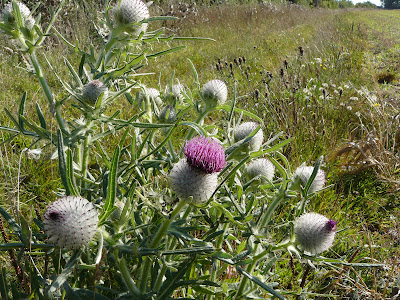In Gloucestershire on family business, we decided to fit in a walk. This one starts from Bibury, famously described by William Morris as the most beautiful village in England.
You cross the clapper bridge over the River Coln and immediately walk past Arlington Row, a group of seventeenth century weavers' cottages now owned by the National Trust. It is the epitome of the picturesque.

From here, you head uphill and quickly leave the village for a path along a field edge. At a crossing path you turn left and head south east towards Coln St Aldwyns. This lovely path follows a ridge with views to the south and then skirts round a hill. This is the view looking back.

After a few yards along a road, the route goes across some flat and uninteresting fields before entering parkland and descending down to the banks of the Coln again on the outskirts of Coln St Aldwyns.

You turn sharply left here for the return leg paralleling the Coln. Gradually you approach the river bank and gain a clearer sense of what the river looks like here.

A climb through woodland and then a gradual descent bring you back to the outskirts of Bibury, where a short detour reveals the delightful church of the Virgin Mary in a quiet close with the primary school opposite and the former manor house (now a hotel) nearby.

The church is Saxon in origin and there are a few identifiable remains of this period as well as Norman doorways, 14th century windows with Decorated tracery and the impressive 15th century tower, unusually placed at the end of the north aisle.
From: Cotswold Walks (Jarrold).
Distance: 6 miles.
Map: Explorer OL 45 (The Cotswolds).
Rating: Four stars.
Sightings
Here is the first fish to feature on this blog: a trout in the clear water at Bibury.

A few butterflies as well: Painted Lady, Small Tortoiseshell, Brimstone, Whites, Speckled Wood and a glimpse of what might have been a Small Copper.
Flower of the day
This Spear Thistle was impressive, although it is of course an Injurious Weed as defined in the Weeds Act of 1959.

Tree of the day
This splendid Ash was standing in the parkland at the edge of Coln St Aldwyns.













































